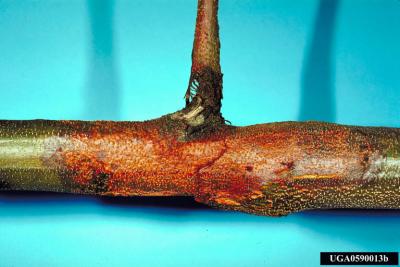
The American chestnut (Castanea dentata) and related Allegheny and Ozark chinquapins (Castanea pumila & Castanea ozarkensis) were once important components of upland forests in eastern North America.
Chestnut blight (causal agent Cryphonectria parasitica) was first reported in 1904, when cankers were observed on trees in the New York Zoological Garden in the Bronx. Over the next several decades, the blight killed more than three billion American chestnuts throughout the species’ natural range. By the 1950s, virtually all chestnut and chinquapins had been reduced to short-lived stump sprouts and disease-ridden shrubs (Burnham et al. 1986).
American chestnut’s range extended from Maine to Mississippi, including nearly every state east of the Mississippi River, plus southern Ontario. Billions of trees occupied this areas constituting about 200 million acres. American chestnut was adapted to a broad range of environmental and climatic conditions, although it preferred well-drained, sandy, and slightly acidic soil, often on slopes and ridges. It grew at every elevation from sea level to higher than 5000 feet. In many areas, especially on Appalachian slopes, chestnut was dominant. In other places it grew in association with oak, hickory, basswood, tulip poplar, and beech, with an ericacious shrub understory. While established seedlings and stump sprouts can persist for years in low light conditions, when conditions are such that light penetrates the canopy, the sapling can grow more quickly than other species. Consequently, its abundance was probably increased by human clearing and burning.
American chestnut provided a consistent nut crop that was consumed by numerous mammals, birds, and insects. As a large tree growing to heights of 70 to 100 feet, and diameters up to 5 feet, with hollow centers (USDA 2022), American chestnut provided habitat for numerous birds, mammals, and herpetofauna that depend on cavities for nesting or sheltering sites. Chestnut wood is very slow to rot. The leaf litter influenced both terrestrial and aquatic ecosystem structure and function in areas where it was a dominant tree.
Humans used the chestnut by harvesting the nuts for themselves and as fodder for their livestock. They used the wood for construction lumber, shingles, fence posts and rails, telephone and telegraph poles, paneling, trim, furniture, coffins, interior decoration and firewood (USDA EIS 2022). Chestnut bark was a primary source of tannin for the leather industry.
In the late 19th century prior to the introduction of chestnut blight, the range of American chestnut was already contracting in the south, apparently as a result of Phytophthora root rot/ink disease (caused by Phytophthora cinnamomi). This pathogen was introduced to the southern United States probably before 1824. Additionally, the Asiatic oak weevil and chestnut gall wasp negatively affect surviving American chestnuts.
Also at the turn of the prior century, American chestnut was increasingly found to the north and northwest of its historical range ( e.g., lower peninsula of Michigan, southwest Wisconsin, Illinois, Iowa, probably hastened by deliberate planting). The original historical range overlapped with the ranges of Ozark and Allegheny chinquapins; these are shrubs and subcanopy trees that produce one nut per bur. Ozark chinquapin was a prominent overstory tree in parts of its relatively small range in the Ozark plateau, where it provided ecosystem services similar to those of the American chestnut farther east.
Early attempts to control spread of Cryphonectria parasitica included quarantine and destruction of diseased trees. These efforts were ineffective because the fungus produces prolific spores that are spread by animals and the wind. Also, Cryphonectria parasitica persists and reproduces on dead or living American chestnuts, chinquapins, and on numerous other tree species, including multiple oak species, maple, hickory, American beech, and tulip poplar. As a result, the fungus (and resulting chestnut blight) remains prevalent in North America.
No wild-type American chestnut tree has been documented to contain full blight resistance, although anecdotally, there appears to be a range of susceptibility (i.e., differences in damage to stems and survival times). Over the past century there has been considerable research on various strategies such as chemical controls, biocontrol (hypovirulence), and radiation treatment of seeds. None have proved effective in controlling blight on a landscape scale in North America.
Breeding for resistance – through crossing American and Asian species – began in the 1920s under the auspices of the U.S. Department of Agriculture’s Office of Forest Pathology. This program was abandoned in 1960. At the same time, Arthur Graves began efforts to develop hypovirulence, a biocontrol method that uses a fungal virus to help attenuate the pathogen, which was later continued by the Connecticut Agricultural Experiment Station. Again, none of these early programs succeeded in producing a fast growing, timber-type (tall and straight) tree with good blight resistance; every candidate fell short in at least one respect.
The American Chestnut Foundation (TACF) began a systematic program of backcrossing hybrid American – Chinese trees with pure American chestnut trees, selecting for blight resistance and American phenotype at each step. This program has resulted in trees with resistance to blight at levels intermediate between susceptible American and resistant Chinese chestnut. However, this approach now appears unlikely to produce a highly blight-resistant chestnut with a genome that is predominantly American. TACF now plans to incorporate the use of transgenic techniques to enhance resistance to the blight fungus (Gustafson et al. 2022).
None of the previous breeding and modification efforts, including TACF back-cross breeding, has succeeded in producing American chestnuts that are sufficiently able to tolerate chestnut blight to be restored to the eastern forest ecosystem. In 1997, the State University of New York (SUNY) College of Environmental Science and Forestry (ESF) established the American Chestnut Research and Restoration Project. a non-profit initiative with the support and close collaboration of TACF. The project has applied biotechnology to insert a gene conveying tolerance of the blight pathogen into the chestnut’s genome. The Project’s goal is to facilitate introgression of the blight tolerance trait into surviving American chestnut population and so ultimately to produce a viable and diverse population to restore the tree as a functioning part of the ecosystem. If this project proves successful, offspring of transgenic trees would include both transgenic and non-transgenic individuals, and therefore, the original wild-type (unmodified) American chestnut will be conserved far into the future.
The ESF project inserted a gene into the chestnut’s genetic structure at multiple locations within many identical individuals grown from a single tree, named, “Darling” (Darling is the surname of a longtime chestnut advocate). The added gene is from wheat, and it promotes the tree to produce an enzyme called oxalate oxidase (OxO). This enzyme doesn’t kill the blight fungus; instead, it detoxifies the oxalic acid (oxalate) produced by the fungus. For details on how the gene was inserted and the chemical processes involved, see the SUNY ESF petition or APHIS PRA or DEIS – sources cited at end of profile.
In 2020, ESF petitioned the USDA Animal and Plant Health Inspection Service (APHIS) to determine that the “Darling 58” (one of the many candidate trees originating from the Darling line) American chestnut tree differs in no other substantive ways from wild chestnuts and traditionally bred hybrids and therefore should be exempted from further regulation. Full deregulation of the transgenic chestnuts would required approval from two other U.S. agencies. The Food and Drug Administration (FDA) has jurisdiction over the safety of chestnuts as food for both people and livestock; the Environmental Protection Agency (EPA) has jurisdiction over whether the OxO gene is a pesticide.
Transgenic chestnut trees were planted more widely in 2023 as part of the regulatory review process. As a result, TACF and partners observed disappointing performance by the experimental trees, most importantly variability in trees’ blight tolerance and reduction in overall fitness. Studies prompted by these concerns determined that the trees being tested were not from the “Darling 58” line. Instead, they were descended from a different experimental injection of the OxO gene, “Darling 54.” In this genetic line, the OxO gene’s location caused deletion of a known gene. This disruption of the tree’s genetic makeup might explain some of the test trees’ poor performance.
Further causing concerns, in all the “Darling” experimental lines, the OxO gene is expressed constitutively – that is, “switched on” all the time. TACF researchers suspect that constitutive promotion appears to impose a high metabolic cost on the trees- which may result in them not being able to compete in a natural forest. Since all trees in the “Darling” line share this condition, TACF is no longer pursuing research efforts on trees with this lineage. Instead, TACF and several research partners are investigating trees descended from other experiments that use a “wound inducible” promoter, which switches on the OxO gene only in cells where the plant has been wounded.
TACF also promises that in the future, it will conduct more extensive testing of candidate genetic lines for efficacy throughout the tree life cycle before seeking approval of regulators. TACF will also strengthen its relationships with cooperators and take steps to ensure continued access by the public to promising genetic lines.
Meanwhile, TACF and its partners are trying to develop a rapid genotyping method to improve the efficiency of its backcross breeding program and exploring whether combining inducible OxO expression with additional genes providing blight resistance introduced through the backcross breeding program.
Ozark Chinquapin Foundation (ozarkchinquapinmembership.org) is currently using traditional breeding and selection processes in an effort to develop blight-resistant chinquapins. The Foundation has informed SUNY that they support the concept of exploring development of transgenic Ozark chinquapin- but the development of a blight resistant Ozark chinquapin using OxO would be many years away.
Separately, the American Chestnut Cooperators’ Foundation (ACCF) has been breeding from persistent American chestnut found in natural areas. ACCF was officially established in 1986 to form the network of cooperators who grow nuts from breeding orchards in Blacksburg, VA and/or make donations to fund ACCF work. ACCF Cooperators are spread throughout the entire native range of the American chestnut, from Mississippi, Alabama and Georgia, out to Indiana and Michigan, and as far North as parts of Ontario, Quebec, and Maine. Since the ACCF’s founding, Cooperators have planted hundreds of thousands of nuts and seedlings. ACCF currently has hundreds of Cooperating growers who report data on their ACCF plantings annually. Long-time Cooperators report ACCF trees growing 50-60 feet, producing nuts and showing blight control.
The oldest trees growing in ACCF plots are over 50 years old; many of which are over 60 feet tall and produce canker response (superficial swellings). Planting is accomplished using nuts, in cleared forest plots. Trees that decline are culled from plots and scionwood from known durably resistant trees is grafted into their root systems Management of plots includes eliminating other hardwood seedlings and invasive competition until the trees are of sufficient size. The ACCF is currently reporting it has five generations of surviving American chestnut families that express durable blight control in both favorable and unfavorable environments. [From the ACCF Board].
SOURCES
Gustafson, E.J., B.R. Miranda, T.J. Dreaden, C.C. Pinchot, D.F. Jacobs. 2022. Beyond blight: Phytophthora root rot under climate change limits populations of reintroduced American chestnut Ecosphere. 2022;13:e3917.
Powell, W.A., A. Newhouse, V. Coffey, L. McGuigan, A. Oakes, K. Breda, D. Mathews, J. Drake, J. Dougherty, J. French, M. Braverman, C. Maynard. Petition under 7 CFR 340.6 to request that the Administrator make a determination that the article should not be regulated under 7 CFR 340.6. Petition 19-309-01p
The American Chestnut Foundation (TACF), 2023. Rescue and Restoration of the American Chestnut.
https://tacf.org/darling-58/ Accessed on Feb 5 2024
United States Department of Agriculture. 2022. State University of New York College of Environmental Science and Forestry Petition (19-309-01p) for Determination of Nonregulated Status for Blight-Tolerant Darling 58 chestnut (Castanea dentata) Draft Environmental Impact Statement July 2022
United States Department of Agriculture. 2022. State University of New York College of Environmental Sciences and Forestry for Determination of Nonregulated Status for Blight-Tolerant Darling 58 American Chestnut Draft Plant Pest Risk Assessment. June 2022



